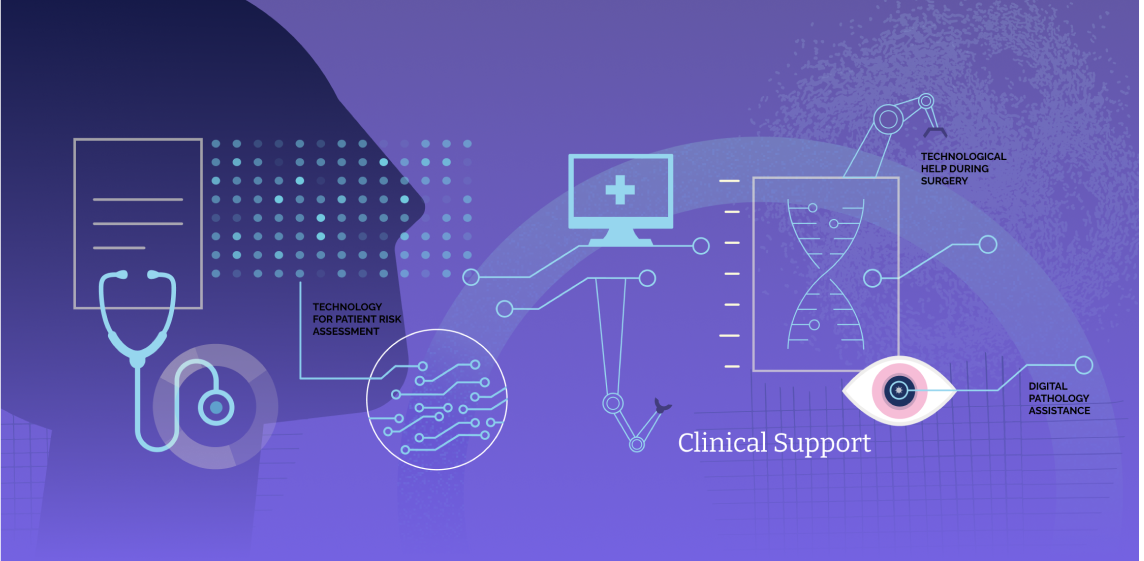Mega Trends in Healthcare
A Micro-Read
AI Healthcare Mega Trends
AI is now a reality in healthcare, though not a megatrend itself. As we start the new year, our team of foresight practitioners have identified impactful healthcare megatrends emerging within the domain of AI that will be crucial to consider when designing services, experiences and solutions for patients, providers and beyond.
In 2023, we witnessed individuals adopting Artificial Intelligence (AI) into their everyday lives as evidenced by the mass adoption and use of services like ChatGPT which sees 1.5 billion web visitors per month.
AI is not just a topic at the dinner table anymore, it is a crucial part of most industries, including their everyday operations and practices, new offerings for customers, and even the solutions being designed for recent business challenges.
Healthcare is no different. Intelligent health has been lurking in the background for a few years now, but with the boom of generative AI, more and more research, innovation and practical use of AI and machine learning is taking shape. As we head into 2024, AI will continue to transform health research, care delivery and the way conditions are diagnosed and treated.

Clinical Support

Clinical Support
Heading
Leveraging Technology for Patient Risk Assessment:
Using AI and machine learning algorithms, HCPs can view patient data and understand their risk of various diseases.
For example, in the endometrial cancer space an AI model was developed and tested to predict women's risk of developing this cancer. Since screenings for the disease aren't widely available until a patient has symptoms, this model combines samples from the patient along with their health data to predict their risk. It has broader potential to be rolled out as a publicly available tool.
Leveraging Technology for Patient Risk Assessment:
Using AI and machine learning algorithms, HCPs can view patient data and understand their risk of various diseases.
For example, in the endometrial cancer space an AI model was developed and tested to predict women's risk of developing this cancer. Since screenings for the disease aren't widely available until a patient has symptoms, this model combines samples from the patient along with their health data to predict their risk. It has broader potential to be rolled out as a publicly available tool.
Leveraging Technology for Patient Risk Assessment:
Using AI and machine learning algorithms, HCPs can view patient data and understand their risk of various diseases.
For example, in the endometrial cancer space an AI model was developed and tested to predict women's risk of developing this cancer. Since screenings for the disease aren't widely available until a patient has symptoms, this model combines samples from the patient along with their health data to predict their risk. It has broader potential to be rolled out as a publicly available tool.
Specific trends that are shaping the Clinical Support mega trend:
Leveraging Technology for Patient Risk Assessment:
Using AI and machine learning algorithms, HCPs can view patient data and understand their risk of various diseases.
For example, in the endometrial cancer space an AI model was developed and tested to predict women's risk of developing this cancer. Since screenings for the disease aren't widely available until a patient has symptoms, this model combines samples from the patient along with their health data to predict their risk. It has broader potential to be rolled out as a publicly available tool.
Technological Help During Surgery:
Leveraging AI and robotic capabilities, HCPs are able to be more precise and could even outsource some surgeries to their robotic counterparts in the future.
For example, at Johns Hopkins University they have developed the Smart Tissue Autonomous Robot (STAR). This robot is equipped with AI and machine learning algorithms, models and robotic surgical capabilities. In a test, it was able to complete laparoscopic gastrointestinal surgery on pig tissue without human assistance.
Digital Pathology Assistance:
Using AI and machine learning algorithms, HCPs can view patient data and understand their risk of various diseases.
For example, a new method has been developed using AI to read hip X-rays and potentially diagnose osteoporosis. This method combines radiomics and analysis methods developed from over 5000 X-rays over 10 years. Using this learning the model is able to look at a hip X-ray and accurately detect osteoporosis, recommending further testing and screening to the patient.
Remote Healthcare

Specific trends that are shaping the remote healthcare mega trend:
Chronic Disease Remote Monitoring:
AI and technology are being used to close some of the patient-HCP gaps, especially in rural or underserved areas and to treat serious diseases like cancer.
For example, Hurone AI launched an initiative in Rwanda where there are only 13 oncologists for 13 million people. This intervention is called Gukiza, it's an app where patients can report their side effects, experiences, and symptoms to their HCPs from their phone so the oncology team can track them regardless of location and provide data driven treatment recommendations.
Remote Biomarker Testing:
Gathering both patient reported outcomes and biometric patient data regardless of patient location.
For example, a startup called Binah.ai allows patients to use any device with a camera to track a range of biomarkers. Patients open the app and look into the camera as their bodily functions are recorded. Everything from blood pressure, heart rate, oxygen saturation to hemoglobin and cholesterol levels are measured non-invasively.
Accessible, At-Home Disease Screening Tests:
Making screenings more widespread especially for underserved patients and dangerous diseases.
For example, Next Gen Jane is a company that takes the menstrual blood from patient's tampons and tests it for early indicators of diseases such as endometrial cancer which are hard to detect until they progress. Individuals can order a test kit that comes to their home and they mail back their sample, with results delivered online.
Predictive Medicine
Specific trends that are shaping the predictive medicine mega trend:
Predicting Adverse Events and Side Effects:
Using AI to get ahead of AEs before they happen and mitigate severity.
For example, a study was conducted using a machine learning algorithm to predict bladder cancer side effects that a patient might experience. By combining patient information, treatment information, and knowledge of bladder cancer, the algorithm was able to predict treatment side effects at the time of prescription at 80.3% accuracy.
Predicting Treatment Efficacy to Support Treatment Decisions:
Knowing ahead of time which drugs will be optimal for which patient leads to better patient outcomes.
For example, Screen Ahead RX is a tool developed at Berkeley School for individualized cancer care. It takes information from all aspects of a patient's health, their cancer's genomic profile, and the treatment information and can predict which treatment options are most likely to have an excellent response from the patient without having to test multiple different options.
Inclusive Clinical Trials and Disease Impact Understanding:
Intentionally creating productsusing AI, that learn about and leverage information about underserved patients (like women and POC).
For example, knowing that women's hormone fluctuations mean they experience health conditions differently from men, Eli Health was created. It tests hormone levels in saliva and using an AI algorithm generates a profile on their app. The profile tells the user what their levels mean for different health risks, conditions, and their implications for fertility and contraception.
Heading
Leveraging Technology for Patient Risk Assessment:
Using AI and machine learning algorithms, HCPs can view patient data and understand their risk of various diseases.
For example, in the endometrial cancer space an AI model was developed and tested to predict women's risk of developing this cancer. Since screenings for the disease aren't widely available until a patient has symptoms, this model combines samples from the patient along with their health data to predict their risk. It has broader potential to be rolled out as a publicly available tool.
Leveraging Technology for Patient Risk Assessment:
Using AI and machine learning algorithms, HCPs can view patient data and understand their risk of various diseases.
For example, in the endometrial cancer space an AI model was developed and tested to predict women's risk of developing this cancer. Since screenings for the disease aren't widely available until a patient has symptoms, this model combines samples from the patient along with their health data to predict their risk. It has broader potential to be rolled out as a publicly available tool.
Leveraging Technology for Patient Risk Assessment:
Using AI and machine learning algorithms, HCPs can view patient data and understand their risk of various diseases.
For example, in the endometrial cancer space an AI model was developed and tested to predict women's risk of developing this cancer. Since screenings for the disease aren't widely available until a patient has symptoms, this model combines samples from the patient along with their health data to predict their risk. It has broader potential to be rolled out as a publicly available tool.
Heading
Leveraging Technology for Patient Risk Assessment:
Using AI and machine learning algorithms, HCPs can view patient data and understand their risk of various diseases.
For example, in the endometrial cancer space an AI model was developed and tested to predict women's risk of developing this cancer. Since screenings for the disease aren't widely available until a patient has symptoms, this model combines samples from the patient along with their health data to predict their risk. It has broader potential to be rolled out as a publicly available tool.
Leveraging Technology for Patient Risk Assessment:
Using AI and machine learning algorithms, HCPs can view patient data and understand their risk of various diseases.
For example, in the endometrial cancer space an AI model was developed and tested to predict women's risk of developing this cancer. Since screenings for the disease aren't widely available until a patient has symptoms, this model combines samples from the patient along with their health data to predict their risk. It has broader potential to be rolled out as a publicly available tool.
Leveraging Technology for Patient Risk Assessment:
Using AI and machine learning algorithms, HCPs can view patient data and understand their risk of various diseases.
For example, in the endometrial cancer space an AI model was developed and tested to predict women's risk of developing this cancer. Since screenings for the disease aren't widely available until a patient has symptoms, this model combines samples from the patient along with their health data to predict their risk. It has broader potential to be rolled out as a publicly available tool.






